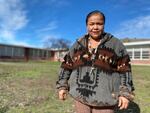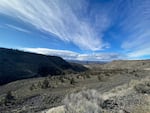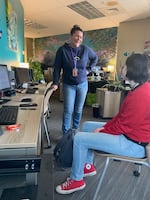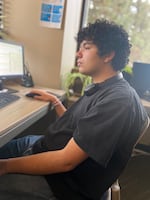Rosanna Jackson, an enrolled member of the Confederated Tribes of the Warm Springs, counts herself as one of the resilient ones. Her childhood in the 1970s and 80s was tough. Home didn’t always feel like a safe place to be.
There’s a stigma that leads to people “not talking about their feelings and not wanting everyone to know that they’re hurt or in pain,” she said of many in her community who have dealt with similar childhood trauma.

Rosanna Jackson, an enrolled member of the Confederated Tribes of the Warm Springs, is heading up the effort to start the first ever suicide prevention helpline run by and for Native youth. Jackson stands in front of her old elementary school on the Warm Springs reservation on Feb. 7, 2024.
Courtesy of Lillian Mongeau Hughes
But that silence can be lethal, Jackson said. Now an adult who has dedicated her life to helping her tribal members be more resilient, Jackson is leading the effort to create the nation’s first suicide helpline staffed by and designed for Native youth.
“I’m hoping that my youth will come out of their shell and help each other,” Jackson said. “It’s OK to not be OK. It’s OK to talk about what’s on your mind.”
Native youth have one of the highest rates of suicide of any demographic in the country, according to federal data. While American Indian and Alaskan Native teenagers reported feelings of sadness and hopelessness that tracked with national averages, they were more likely than their peers of other races to seriously consider suicide, to make a plan to die by suicide and to attempt suicide. That’s according to the latest youth risk behavior survey for high schoolers by the U.S. Centers for Disease Control and Prevention.
In Oregon, which has a suicide rate above the national average, 20% of Native American 11th graders said they had seriously considered suicide in the last year, according to the results of the 2022 Student Health Survey. Among white students answering the survey, 16% said they had seriously considered suicide.
Native leaders say their young people are facing an acute mental health crisis and could particularly benefit from the kind of support a helpline run by and for Native youth would provide.
There are only a small number of suicide crisis lines in the country that are staffed by young people. Youthline, the 21-year-old program in Oregon that is behind Jackson’s effort, is one of them. California and Arizona also have long-standing peer lines for teenagers. And while there’s no single national directory of every suicide crisis call center, most don’t cater to people with a specific identity. The Trevor Project is a large helpline for LGBTQ+ youth, but volunteer counselors must be 18 or older to take calls.

Teens at the Bend, Ore., office of Youthline, a peer-to-peer suicide prevention and mental health crisis helpline, answer texts from young people on Feb. 7, 2024. Several texters that day said they weren’t suicidal, but just needed someone to listen.
Courtesy of Lillian Mongeau Hughes
If it’s successful, Jackson’s program would be the first crisis line in the nation designed for Native youth.
While many of the issues affecting Native youth are universal to young people today, including the isolation and loss suffered during the pandemic and the threat of climate change, other reasons for desperation in this group are more specific. They include intergenerational trauma (when harmful stress experienced by adults affects how they parent), an ongoing addiction epidemic, poverty and a lack of rural infrastructure. People living on reservations may not have paved roads or potable water, let alone easy access to mental health services.
Annamarie Caldera, 18, who lives near Jackson on the Warm Springs reservation, is on track to be the first young person to pick up the phone — or, more likely, to respond to texts — at the nascent Youthline Native. She was recruited by Jackson last spring and, nearly a year later, has almost completed the 64 hours of training required to answer calls.
Caldera said she was excited at the prospect of finally taking calls. “I get to help people and pass on my vibes to them,” she said.
Related: Washington’s Native and Strong Lifeline assists a journey of healing
Caldera was sitting in the reservation’s new call center, a converted classroom decorated with a giant mural depicting three young Native people in traditional garb on one wall and a mural featuring several Pacific Northwest animals in front of Mt. Jefferson on another. The local tribal artist who designed the murals also added a portrait of a young man the tribes lost to suicide in 2020.
While she’s dedicated to supporting her Indigenous peers who are facing down despair, Caldera said it’s important that people know that Native teenagers are not always — or even often — thinking about suicide.
“I’ve had a few people ask me on my social media if … all we think about is killing ourselves and drinking and smoking,” she said. Most of those who’ve asked, she said, are white. “It’s not accurate — not at all.”
She said she spends far more time thinking about school and ways to help her community, which is why she wants to be a call taker for Youthline Native.
“I think it is really important because you’re also Native and you can understand your peers more than any other,” Caldera said.

The Deschutes River canyon borders the Warm Springs Reservation on the high desert of Central Oregon on February 7, 2024. Three tribes – the Wascoes, the Warm Springs and the Paiutes – were forced from their original territory onto the reservation beginning in the mid-1800s, according to the tribes’ website. They banded together as the Confederated Tribes of Warm Springs in 1937.
Courtesy of Lillian Mongeau Hughes
Starting in the 1950s and gaining speed in the 1970s, suicide crisis lines for all ages have been set up by small nonprofits serving limited geographical regions. This didn’t work well for people without a local line or who called at a time no volunteer was available. Moreover, many people didn’t even know the lines existed. To address those issues, local crisis lines joined together in 2005 under a single number — now 988 — that anyone in the country could call at any time.
Volunteers and staff at more than 200 crisis centers now answer approximately 5 million annual calls and texts to 988. People who call the three-digit number are offered the chance to connect to a service for veterans or for LGBTQ+ youth and young adults, all groups at especially high risk for suicide. There’s also a Spanish-language option and an American Sign Language option for video phone callers.
But there is no national Native suicide prevention helpline.
There’s a line called Native & Strong, based in Washington state that is staffed around the clock by Native counselors, but it’s only available to callers with a Washington area code. And there’s the All Nations Hotline, staffed by counselors from the Ponca, Omaha, Lakota and Winnebago tribes for eight to 16 hours a day, but it’s not part of the 988 network.
Youthline is part of the 988 network and there are adults monitoring the line at all hours, even when young people aren’t available to take calls. Although Youthline Native has not fully launched, Youthline’s existing call takers are prepared to talk to anyone who texts “teen2teen” or “native” to 839863. People can also call 877-968-8491 or start a chat from the Youthline website.
Related: Homeless youth in Oregon rebuild their lives with $1,000 a month support
Since it’s usually impossible for crisis lines to ensure that the person answering the phone is a match for the person calling, crisis line organizers agree that counselors must be prepared to respond to all callers no matter their age, race, gender or sexual orientation.
And yet, talking to someone with the same background can be incredibly important and healing, especially for Native people, said Rochelle Hamilton, the head of Washington state’s Native & Strong line.
“If you are an Indigenous person — often if you go to talk to a therapist or counselor who is non-Indigenous, you spend the majority of your time talking about what it is to be Indigenous,” said Hamilton, an enrolled member of the Ehattesaht First Nation and a descendent of the Tulalip tribes.
Not only is that annoying and exhausting, especially for someone in a bad mental space, she said, it prevents the therapist and client from addressing the actual crisis. Anticipating some level of disconnect and accompanying frustration, many Native people in crisis never pick up the phone, Hamilton said.
“Indigenous people often and for good reason don’t have a lot of trust outside of their communities,” she said. “They’re relying more on each other. They want to look to each other when they need something.”

On Feb. 7, 2024, supervisor Mel Butterfield chats with Stevie Irvine, 16, who has been answering calls and texts for Youthline Bend since 2023. Irvine, who is a youth chaplain at her Unitarian Universalist church, said she feels well suited to the work; she hopes to pursue a master's in divinity after college.
Courtesy of Lillian Mongeau Hughes
When someone calls Native & Strong, the counselor answers by identifying themselves and their tribal or cultural affiliation. Callers know right away that the counselor is saying “I’m Indigenous and I know where you’re from,” Hamilton said.
A non-Native state representative, Tina Orwall, identified the need for a tribal 988 line and advocated for its funding. An existing crisis call center got the contract from the state. The call center consulted formally with tribal leaders who helped to design the Native & Strong program.
Since Native & Strong started taking calls in late 2022, the nearly 30 folks on staff have answered the phone more than 5,000 times, a number that far exceeds original expectations. The high usage of the line proves it’s needed, Hamilton said.
But even with funding secured, Youthline Native has faced more hurdles. Jackson initially had six teenagers interested in being part of the helpline. But only Caldera is close to completing the training. Three others have just started.
Peer-to-peer crisis lines for young people are always hard to staff. Young people are often required to take calls from a physical call center as a measure of protection for their own mental well-being. That creates geographic limits on where volunteers can be pulled from.
Partly to attract a more diverse group of call takers, Oregon’s Youthline recently added three new call centers. In addition to the original center in Southwest Portland, there are call centers in the more diverse neighborhood of East Portland, in Warm Springs and in Bend.
When it’s up and running, the small Warm Springs call center will be a lot like the one in Bend, where Eddie Lopez, 17, is among the young people answering the phones.

Eddie Lopez, 17, of Bend, Ore., responds to a text from a young person who said they felt unloved on Feb. 7, 2024. Lopez, who hopes to pursue a career in music, told the texter they were courageous for reaching out and helped them find contact information for local mental health care providers.
Courtesy of Lillian Mongeau Hughes
On a chilly February night Lopez sat in the cozy call center with half a dozen other teen call takers and three adult supervisors. Lopez moved to Bend, about an hour south of Warm Springs, when he was 15. The transition was brutal, he said. But the gracious welcome he was offered when he arrived inspired him to give something back.
“Obviously, I won’t understand people from all walks of life,” said Lopez, whose family is Mexican-American. But “mental and emotional support is kind of universal in a way,” he said. “Everyone likes to be validated. Everyone likes to feel like they’re not alone. I’m helping even if I don’t understand them as people.”
Lopez read a message on his computer screen from a person saying they felt unloved. Call takers at Youthline Native will use the same program to field incoming calls and texts.
“I also feel better when I talk about my feelings,” the texter wrote. “I just want to heal from them, but I don’t know how to heal?”
The key when texting people who reach out for help is to make sure they know that they are not alone and that their feelings are valid, Lopez said. The teens are taught to avoid giving specific advice; instead, they ask questions.
“I’m very thankful you shared that with me,” Lopez texted back under his alias. “It takes a lot of bravery to be vulnerable. Have you talked to anyone about what you’ve been going through?”
Related: Pacific Northwest organizations work to support queer Indigenous youth
The goal is for the texter to say how they will take care of themselves for that evening, at least. “Since we’re so short-term, we kind of have to, like, motivate them to want to help themselves in a way,” Lopez explained. The teen volunteers may list things other people do to calm down, like take a walk or listen to music.
Counselors on the Native & Strong line follow the same protocol, but they also list culturally specific practices, like smudging (the burning of sacred herbs), talking to an elder or eating a traditional food.
Some callers don’t have an Indigenous mode of self-care they rely on, Hamilton said, so counselors will urge them to find one as a way to reconnect with their heritage.
“The reason we are in the place we are right now is because of loss of connection,” Hamilton said.
Both Hamilton and Jackson said they are determined to prove the need for Native-specific call lines and then expand their models. They want to see a nationally available, Native-run helpline available to every Indigenous person struggling with thoughts of suicide.
There was some encouraging news buried in the most recent CDC data on suicide released last year. The rate of suicide for young people fell 8% in 2022 and for Native people it fell 6%. Yet experts say a one-year drop is hardly a trend.
Back in Bend, a call taker named Sarah Hawkins, 18, was chatting with someone worried about a rumor being spread about them at school. Following protocol as the conversation wrapped up, Hawkins asked the middle schooler what would help them tonight.
“IDK,” the texter replied. “Frankly, just talking about it made me feel so much better.”
If you or someone you know is thinking about suicide, you can speak with a trained listener by texting or calling 988, the national Suicide and Crisis Lifeline.
This story was produced by The Hechinger Report, a nonprofit, independent news organization focused on inequality and innovation in education.


